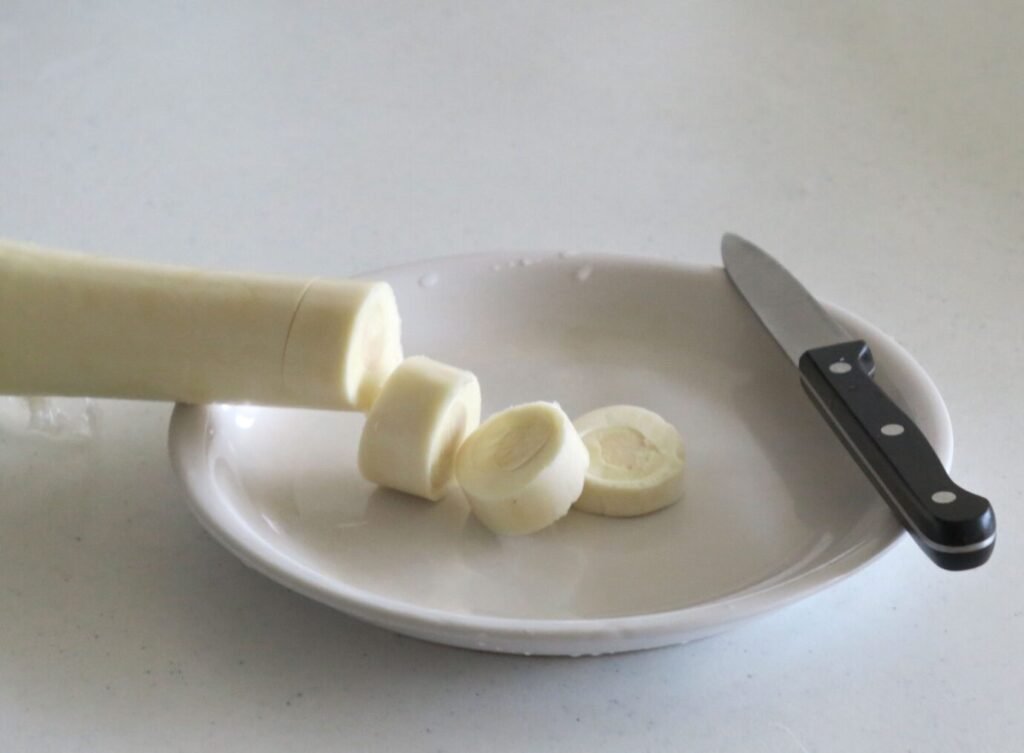If there’s one ingredient that can instantly transport me back to my childhood home in Brazil, it’s heart of palm. Known as “palmito” in Portuguese, this delicate white vegetable has long been a staple in Brazilian cuisine. Growing up, I remember it as a regular guest in our salads, pies, pizzas, and even savory pastries like pastéis and empadas.
Here in the U.S., it’s not nearly as common in traditional recipes. Most people only encounter it in canned form, neatly stacked in the supermarket aisles. However, in recent years, its unique texture—often likened to tender meat—has made it a popular ingredient among vegan cooks. Its versatility in replacing meat in everything from sandwiches to salads has given this ingredient a new lease on life in American kitchens. Beyond that, heart of palm has also gained popularity in the form of pupunha pasta—an alternative favorite among gluten-free enthusiasts.
But there’s so much more to heart of palm than its culinary appeal. This vegetable, deeply rooted in South American history, tells a story of sustainability, biodiversity, and changing agricultural practices. Let’s dive into its origins and explore how we can enjoy it responsibly while supporting both our health and the environment.
A Brief History of Heart of Palm in Brazil and South America

The consumption of heart of palm dates back centuries, with indigenous tribes across the Amazon using it as a dietary staple. Known as “palmito” in Brazil, it was originally harvested from the Euterpe edulis, or the Atlantic Forest palm, found predominantly in the southeastern regions of Brazil. The versatility of the heart of palm made it a key ingredient not only in traditional recipes but also as a source of sustenance during long periods of travel through dense forests.
However, the increasing demand for this delicacy in the 20th century led to severe overharvesting. This resulted in a dramatic decline in native populations of the Euterpe edulis, pushing it onto the endangered species list. To combat this, local governments began implementing regulations and incentivizing the cultivation of sustainable varieties, leading to a shift towards other species, such as Bactris gasipaes, known as peach palm or pupunha, which grows more quickly and is easier to harvest without harming the entire plant.
The Cultivation of Heart of Palm Today

The majority of the heart of palm consumed worldwide now comes from Brazil and neighboring South American countries, such as Ecuador and Colombia. Modern cultivation focuses on the peach palm (pupunha), which allows for multiple stems to grow from the same base, ensuring that cutting a single stalk doesn’t kill the entire tree. This sustainable approach is pivotal in reducing the environmental footprint of heart of palm production.
Yet, while peach palm cultivation is more sustainable, not all operations are created equal. According to a study published by the Brazilian Agricultural Research Corporation (EMBRAPA), small-scale, organic farms using agroforestry methods produce higher-quality palms and have a significantly lower impact on local biodiversity than large-scale monoculture plantations (EMBRAPA, 2022).
Making Sustainable Choices

For consumers in the U.S. looking to include heart of palm in their diets, opting for sustainably farmed or certified organic options is crucial. The “Rainforest Alliance Certified” label, for instance, indicates that the product was harvested in a manner that protects ecosystems and supports local communities. It’s also worth checking for brands that source from small-scale farmers, as these often prioritize sustainability and fair labor practices.
Nutritional Value and Health Benefits
Heart of palm isn’t just a culinary delight—it’s also packed with nutrients. A 100-gram serving of fresh heart of palm contains approximately:
- Calories: 36
- Protein: 2.5 grams
- Fiber: 3.5 grams
- Vitamin C: 10% of the daily recommended value
- Iron: 25% of the daily recommended value
Rich in potassium and low in fat, heart of palm is an excellent choice for those looking to maintain cardiovascular health. According to a study conducted by the University of São Paulo, its high potassium content helps regulate blood pressure, while its low glycemic index makes it suitable for individuals with diabetes (University of São Paulo, 2020).
The Future of Heart of Palm in South America

With increasing awareness of environmental issues, the future of heart of palm production in South America lies in expanding sustainable practices and promoting alternative species that can be cultivated without compromising the region’s biodiversity. Programs led by non-profits, such as Instituto Socioambiental in Brazil, are working with local communities to develop agroforestry projects that integrate peach palm cultivation with the preservation of native flora and fauna.
In conclusion, heart of palm is more than just a culinary treat. It’s a product deeply connected to the cultural and environmental history of South America. As Americans become more conscious of their food choices, opting for sustainably sourced heart of palm not only supports healthy diets but also contributes to the preservation of delicate ecosystems across the Amazon.
By making educated decisions, consumers can savor the delicate flavor of heart of palm while ensuring that this ancient crop continues to thrive for generations to come.

FAQ
1. What is heart of palm?
Heart of palm is a white, cylindrical vegetable harvested from the inner core of certain palm trees. It has a delicate flavor and tender texture, making it a popular ingredient in salads, savory dishes, and as a meat substitute in vegan recipes. In Brazil, it’s known as “palmito” and is often featured in local cuisine.
2. Where does heart of palm come from?
Heart of palm is primarily sourced from South American countries such as Brazil, Ecuador, and Colombia. Originally harvested from the Atlantic Forest palm (Euterpe edulis), overharvesting led to the shift toward sustainable species like the peach palm (Bactris gasipaes), which is now the most commonly cultivated variety.

3. What does heart of palm taste like?
Heart of palm has a mild, slightly nutty flavor and a texture that’s often described as tender and slightly crunchy. Its neutral taste allows it to absorb flavors well, making it versatile for use in a variety of dishes.
4. What is pupunha?
Pupunha is a common Brazilian term for the peach palm (Bactris gasipaes), a species of palm tree primarily cultivated for sustainable heart of palm production. Unlike the native Atlantic Forest palm, pupunha is a renewable source of heart of palm, as it grows multiple shoots from the same base, allowing it to be harvested without harming the plant. This makes pupunha a popular and eco-friendly choice for producing heart of palm. It has a tender texture and a slightly sweet flavor, making it ideal for use in a variety of recipes, including pupunha pasta—a favorite among those seeking gluten-free alternatives.
5. Is heart of palm healthy?
Yes, heart of palm is a nutrient-dense food. It’s low in calories, rich in fiber, and contains essential nutrients like potassium, iron, and vitamin C. Its low glycemic index and high potassium content also make it beneficial for cardiovascular health and blood sugar regulation.
6. Is heart of palm sustainable?
It can be, depending on how it’s harvested. Traditional heart of palm harvesting from the Euterpe edulis palm often killed the entire tree, leading to deforestation and endangered species status. However, the shift to sustainable varieties like the peach palm, which can regrow after harvest, has made heart of palm production more eco-friendly. Look for products labeled “Rainforest Alliance Certified” or those from small-scale, organic farms to ensure sustainable sourcing.
7. Is heart of palm gluten-free?
Yes, heart of palm is naturally gluten-free. It’s an excellent option for people with celiac disease or those avoiding gluten. The recent trend of pupunha pasta—made entirely from heart of palm—has become a popular gluten-free alternative to traditional pasta.
8. Can I eat heart of palm raw?
Yes, heart of palm can be eaten raw. Fresh heart of palm is often served in salads or as part of a charcuterie board. Its tender texture and mild flavor make it ideal for raw consumption. However, the most commonly available form in the U.S. is canned, which is already cooked and ready to eat.
9. How do I store heart of palm?
If you have fresh heart of palm, it should be stored in the refrigerator and consumed within a few days. Canned heart of palm, on the other hand, can be kept in the pantry until opened. Once opened, store any leftovers in a sealed container in the refrigerator and use them within a week.
10. Where can I buy heart of palm?
Heart of palm can be found in most grocery stores in the canned vegetable aisle. Specialty stores or Latin American markets may also carry fresh heart of palm, particularly in areas with a large Latin American community. You can also purchase it online through retailers specializing in exotic or health foods.
11. Is heart of palm safe to eat for people with food allergies?
Heart of palm is generally safe for most people and is not known to cause allergic reactions. However, as with any food, it’s always recommended to try a small amount if you have a history of allergies to other plants or vegetables.
12. Why is heart of palm expensive?
Heart of palm can be pricey due to the labor-intensive harvesting process and the need for sustainable farming practices. Additionally, fresh heart of palm is perishable and requires careful handling, which contributes to its cost. Canned varieties tend to be more affordable and widely available.
13. What are the environmental impacts of heart of palm production?
The environmental impact depends on the harvesting methods and palm species used. Overharvesting of native species like the Euterpe edulis has led to deforestation and habitat loss. However, sustainable farming of the peach palm (Bactris gasipaes), which allows for regrowth after harvest, has minimized negative impacts. Supporting certified organic and sustainable sources is essential for reducing the environmental footprint.
14. Can I grow my own heart of palm?
Growing heart of palm can be challenging, as it requires specific tropical conditions. If you live in a warm, humid climate similar to the southern U.S., it might be possible to grow certain species like the peach palm. However, it’s not a common home garden crop due to its long maturation period and need for specific care.
Heart Palm Recipes
Heart of Palm Fricassee

Ingredients
- 1 (6 oz) can of corn kernels
- 1 (7 oz) container of heavy cream
- 1 (7 oz) jar of cream cheese spread
- 1/2 cup of whole milk
- Salt to taste
- 1/2 medium onion, chopped
- 1 (19 oz) jar of hearts of palm, chopped
- Chopped green onions to taste
- Shredded mozzarella cheese to taste
- Crispy potato sticks to taste
Instructions
Prepare the Ingredients
Gather all your ingredients for the heart of palm fricassee: corn, heavy cream, cream cheese spread, milk, salt, onion, hearts of palm, green onions, mozzarella cheese, and potato sticks.
Make the Cream Base
In a blender, combine the corn, heavy cream, cream cheese spread, milk, and a pinch of salt. Blend until smooth and creamy. Set the mixture aside.
Sauté the Onion and Hearts of Palm
In a large skillet, heat 1 tablespoon of olive oil over medium heat. Add the chopped onion and sauté until it becomes translucent.
Cook the Hearts of Palm
Add the chopped hearts of palm to the skillet and cook for about 5 minutes, stirring occasionally to ensure even cooking.
Combine with the Cream Base
Pour the blended cream mixture into the skillet with the hearts of palm. Stir well and let it simmer for about 3 minutes, allowing the flavors to meld.
Transfer to a Baking Dish
Pour the mixture into a baking dish and sprinkle with chopped green onions and shredded mozzarella cheese.
Bake
Preheat your oven to 350°F (180°C) and bake the fricassee for about 20 minutes, or until the cheese is melted and the top is lightly golden.
Add the Crispy Potato Sticks
Remove from the oven and top generously with crispy potato sticks.
Serve
Serve the heart of palm fricassee with white rice and enjoy. Bom apetite!
Creamy Heart of Palm Soup in Bread Bowl

Ingredients
- 1 round Italian bread loaf
- Butter to taste
- Olive oil to taste
- Black pepper to taste
- Fresh thyme to taste
- 1/2 medium onion, chopped
- 1 garlic clove, minced
- Chopped celery to taste
- 1 (19 oz) jar of hearts of palm, chopped
- Nutmeg to taste
- Salt to taste
- 1 cup of heavy cream
- Grated cheese to taste
Instructions
- Prepare the Bread Bowls
Slice off the top of each Italian bread loaf and carefully hollow out the inside, leaving a thick shell to create a bread bowl. Set aside the removed bread pieces (crumbs). - Butter and Season the Bread
Spread butter inside the bread bowls and on the lids. Place the bread bowls and the reserved crumbs on a baking sheet. Drizzle with olive oil and season with black pepper and fresh thyme. - Toast the Bread
Preheat the oven to 350°F (180°C) and bake the bread for about 15 minutes until lightly toasted and golden. Remove from the oven and set aside. - Sauté the Aromatics
In a large skillet, heat 1 tablespoon of olive oil over medium heat. Add the minced garlic and sauté until fragrant. Add the chopped onion and celery and cook until the onion is soft and translucent. - Add the Hearts of Palm
Stir in the chopped hearts of palm, season with nutmeg, black pepper, and salt. Sauté for a few more minutes to blend the flavors. - Simmer with Palm Water
Pour in the liquid from the hearts of palm jar and bring to a boil. Let it simmer for 3-4 minutes to concentrate the flavors. - Blend Until Creamy
Carefully transfer the mixture to a blender and blend until smooth and creamy. Return the mixture to the skillet. - Incorporate the Heavy Cream
Pour in the heavy cream and stir well. Allow the soup to simmer on low heat until it just starts to boil. Remove from heat immediately to prevent overcooking. - Serve in the Bread Bowls
Spoon the creamy heart of palm soup into the toasted bread bowls. Top with grated cheese and serve with the toasted bread crumbs on the side for dipping. - Enjoy!
Serve hot and enjoy this cozy, flavorful heart of palm soup in its edible bowl. Bom apetite!
Heart of Palm Moqueca

Ingredients
- 1 medium onion, sliced into rings
- 1 medium tomato, sliced into rings
- 1/2 small red bell pepper, thinly sliced
- 1/2 small yellow bell pepper, thinly sliced
- 1/2 tablespoon chopped cilantro (optional)
- 1 tablespoon chopped parsley
- 10.5 oz (300g) hearts of palm, sliced into rings
- 1/2 red chili pepper (dedo-de-moça), seeds removed and chopped
- 1/2 cup of water
- 4 tablespoons of light coconut milk
- Olive oil for greasing
Instructions
- Layer the Ingredients
Lightly grease a medium-sized pan with a drizzle of olive oil. Layer the sliced onion, tomato, red and yellow bell peppers, cilantro, parsley, and hearts of palm in the pan. - Add the Chili and Water
Sprinkle the chopped red chili pepper over the layered vegetables. Pour in the water, cover the pan, and cook on low heat until the vegetables are tender, about 10-15 minutes. - Incorporate the Coconut Milk
Once the vegetables have softened, add the light coconut milk. Stir gently and simmer for an additional 5 minutes until the sauce thickens slightly and the flavors meld together. - Serve
Serve your heart of palm moqueca hot, accompanied by a side of brown rice. Enjoy the vibrant flavors of this plant-based take on a Brazilian classic!
Tip: For a richer flavor, you can also add a splash of olive oil over the top before serving and garnish with extra chopped parsley.



